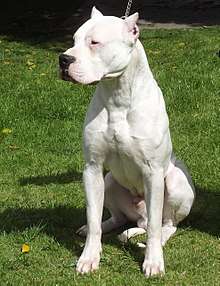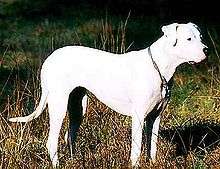Dogo Argentino
 | |||||||||||||||||||||||||
| Other names | Argentine Dogo | ||||||||||||||||||||||||
|---|---|---|---|---|---|---|---|---|---|---|---|---|---|---|---|---|---|---|---|---|---|---|---|---|---|
| Common nicknames | Dogo | ||||||||||||||||||||||||
| Origin | Argentina | ||||||||||||||||||||||||
| |||||||||||||||||||||||||
| |||||||||||||||||||||||||
| Domestic dog (Canis lupus familiaris) | |||||||||||||||||||||||||
The Dogo Argentino is a large, white, muscular dog that was developed in Argentina primarily for the purpose of big-game hunting, including wild boar; the breeder, Antonio Nores Martínez, also wanted a dog that would exhibit steadfast bravery and willingly protect its human companion. It was first bred in 1928, from the Cordoba Fighting Dog along with a wide array of other breeds including the Great Dane.
Appearance
The Dogo Argentino is a large white short-coated dog with muscular and strong body that rarely has any markings (any type of marking or spot on the coat is considered a flaw).[1] While it is not accepted in many of the clubs, a Dogo Argentino can have a black spot on its head known as 'pirata' and it is accepted by the Federación Cinológica Argentina.[2]
Breed Standard Height: for females is 60–65 centimetres (24–26 inches) and for males is 60–68 centimetres (24–27 inches), measured at the withers.[3] Weight: from 40–45 kilograms (88–99 pounds).[3] The length of the body is just slightly longer than the height. The length of the front leg (measured from point of elbow to the ground) is approximately equal to one-half of the dog's height at the withers. The head has a broad, slightly domed skull and the muzzle is slightly higher at the nose than the stop, when viewed in profile. The tail is set low, thick at the base and tapers to a point. It has been described as looking similar to the American Bulldog but very tall with a solid white coat. The breed has also been described as looking similar to the American Pit Bull Terrier, even though the American Pit Bull Terrier is far smaller (13.5 to 27 kilograms).[4]

History
In 1928, Antonio Nores Martinez, a medical doctor, professor and surgeon, set out to breed a big game hunting dog that was also capable of being a loyal pet and guard dog. Antonio Martinez picked the Cordoba Fighting Dog to be the base for the breed.[5] This breed is extinct today, but it was said that as a large and ferocious dog, it was a great hunter. Martinez crossed it with the Great Dane, Boxer, Spanish Mastiff, Old English Bulldog, Bull Terrier, Pyrenean Mastiff, Pointer, Irish Wolfhound and Dogue de Bordeaux.[5] Nores Martinez continued to develop the breed via selective breeding to introduce the desired traits.
Temperament
Dogos are big-game hunters and are also trained for search and rescue, police assistance, service dogs, guide for the blind, competitive obedience, Schutzhund and military work.[1]
The Dogo Argentino because of its purpose, is very stubborn and pain tolerant. This combined with the breed's natural intelligence and domineering tendencies mean that this dog is not suitable for inactive or inexperienced homes, and is ideal for a working home, or at a minimum a very active home. The breed needs an experienced owner and firm leadership, and is not ideal as a pet or service dog role, though it has been successful in the latter.
The Dogo is an intelligent and courageous dog with a strong, natural instinct to protect its home and family. Dogos are very social dogs and are happiest when included in all family activities. Dogos make a strong distinction between familiar people and strangers, so it is imperative that they be well trained and socialized at an early age.
Dogos are hunters of great courage and endurance, and will work individually or in packs. They have also successfully been used in police protection work. An unsteady temperament is a serious fault. {UKC Breed Standard} The Dogo has a life expectancy of 10 to 12 years.[6]

Health
As in the Dalmatian, white Boxer, and the white Bull Terrier, the dogo may experience pigment-related deafness. There is possibility of an approximate 10% deafness rate overall with some dogos afflicted uniaurally (one deaf ear) and some binaurally (deaf in both ears). Studies have shown that the incidence of deafness is drastically reduced when the only breeding stock used is that with bilaterally normal hearing.[7][8][9]
Hunting and legality

While the Dogo Argentino was bred primarily from the extinct Cordoba Fighting Dog, it was bred to be a cooperative hunter, i.e. to accompany other catch dogs and bay dogs on the hunt without fighting with the other dogs. Aggressive traits inherent in the Cordoban Dog were specifically bred out to enable a stable cooperative nature in a pack. However, in areas where illegal dog fighting continues, the Dogo Argentino has been used for fighting due to its fearless nature and great stamina.[10]
The Dogo Argentino is banned or has ownership restrictions in certain countries including Ukraine, Denmark, Iceland, Fiji,[11] Australia, New Zealand, Singapore and the Cayman Islands. In the United Kingdom, under the Dangerous Dogs Act 1991, it is illegal to own a Dogo Argentino without lawful authority.
See also
- Bombon (film) Carlos Sorín's, a 2005 film starring a Dogo Argentino named Gregorio
- Alano Español
- Cimarrón Uruguayo
- Cordoba Fighting Dog
- Dogo (dog type)
References
- 1 2 Rice, Dan (1 March 2001). Big Dog Breeds. Barron's Educational Series. pp. 152–153. ISBN 978-0-7641-1649-0. Retrieved 2010-02-15.
- ↑ "Dogo Argentino Dog Breed Information and Pictures". www.dogbreedinfo.com. Retrieved 2017-11-01.
- 1 2 "Dogo Argentino" (PDF). Federation Cynologique Internationale. 2 August 2012. Retrieved 7 December 2014.
- ↑ Stahlkuppe, Joe (1 April 2000). American Pit Bull Terrier Handbook. Barron's Educational Series. p. 19. ISBN 978-0-7641-1233-1.
- 1 2 Marien-de Luca, Catherine. "Dogo Argentino blood lines".
- ↑ "Dogo Argentino". United Canine Association.
- ↑ Strain, G. M. (1993). "Deafness assessment services by means of the brainstem auditory-evoked response". Journal of veterinary internal medicine / American College of Veterinary Internal Medicine. 7 (2): 104–5. PMID 8501696.
- ↑ Cargill, E. J.; Famula, T. R.; Strain, G. M.; Murphy, K. E. (2004). "Heritability and segregation analysis of deafness in U.S. Dalmatians". Genetics. 166 (3): 1385–93. doi:10.1534/genetics.166.3.1385. PMC 1470800. PMID 15082557.
- ↑ Strain, G. M. (1992). "Brainstem auditory evoked potentials in veterinary medicine". British Veterinary Journal. 148 (4): 275–8. doi:10.1016/0007-1935(92)90080-K. PMID 1498641.
- ↑ "The Complete Guide to Dogo Argentino". Kevin Winslet. Retrieved 30 August 2018 – via Google Books.
- ↑ "Fiji Pet Passport Regulations". Pet Travel, Inc. Retrieved 2017-03-27.
| Wikimedia Commons has media related to Dogo Argentino. |